‘I came to Los Angeles for two reasons,’ David Hockney said in an interview with Dian Hanson in 2009. ‘The first was a photo by Julius Shulman of Case Study House #21, and the other was AMG’s Physique Pictorial’ – AMG being the Athletic Model Guild, founded in 1945, the premier producer of homoerotic nude photography in the form of ‘beefcake’ magazines. But on arrival in California, the land of beefcake men posing next to minimalist houses, one particular feature of the architecture, previously only seen in black and white photographs, struck Hockney with fresh intensity: ‘as we flew in over Los Angeles I looked down to see blue swimming pools all over, and I realised that a swimming pool in England would have been a luxury, whereas here they are not, because of the climate.’
Without yet knowing it, Hockney had discovered his great subject. The swimming pool would become the setting for many of his major paintings of the 1960s and 1970s, and his representations of Los Angeles houses would become defining images in the cultural identity of Southern California. If there is a certain irony in the fact of a Yorkshireman becoming the person to reveal California to itself, as if nobody truly knew what it looked like before, there is no doubt that California gave much to Hockney in return. His paintings of LA seem to open up an idyllic world of leisure, bright light and sexual openness, totally removed from the greyness and repression of the Britain he had left behind. The dark sides of 1960s social optimism are perhaps lurking behind his pictures by a sort of negative implication: the naked young men might be waiting to hear if they’ve been drafted for service in Vietnam, while the private backyard pools, populated by one or two rich-looking white people, recall the crowded municipal pools that were sites of acute racial tension in the same period. But for the single moments that the paintings capture, Hockney’s images of LA are utopian spaces of blissful gay domesticity in which it seems as if it will be afternoon forever, everybody will be beautiful and nobody will need to work.
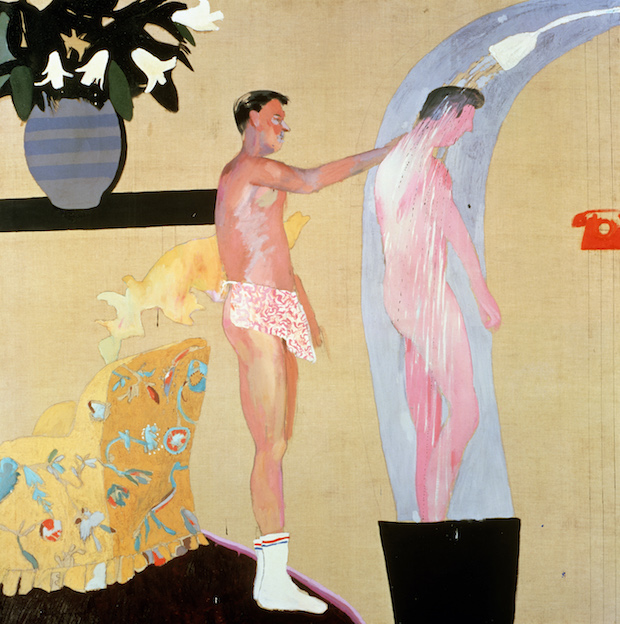
Domestic Scene Los Angeles (1963), David Hockney. © David Hockney
The initial excitement of Californian backyard swimming pools for Hockney was as a setting for private views of the naked or semi-naked male body. Physique Pictorial was a powerful influence on Hockney’s imagination even before he moved to LA. Domestic Scene, Los Angeles (1963), a painting that shows two naked men showering, was based on a picture from the magazine and was completed before he left England. But soon the technical challenge of painting water itself became an equal interest for Hockney. When intense sunlight hits water it reflects in sensuous curves, wobbles off ripples and flickers against a serene surface, in ways that present the artist with remarkable challenges, as Hockney has explained: ‘In the swimming pool pictures, I had become interested in the more general problem of painting the water, finding a way to do it. It is an interesting formal problem; it is a formal problem to represent water, to describe water, because it can be anything. It can be any colour and it has no set visual description.’
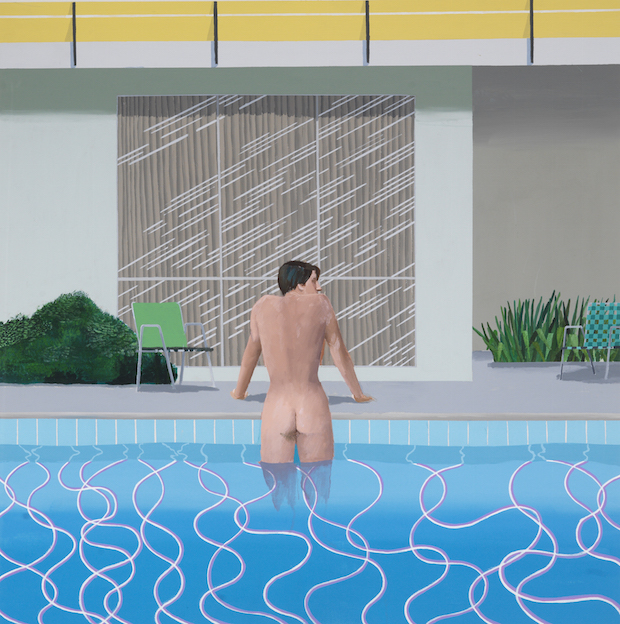
Peter Getting Out Of Nick’s Pool (1966), David Hockney. Photo: Richard Schmidt; © David Hockney
Hockney found a remarkable variety of means of representing water in his pool pictures. Sometimes the play of light on the surface is represented through squiggly white lines running across the surface, as in Sunbather or Peter Getting Out of Nick’s Pool (both 1966), and sometimes through Dubuffet-like patches of variegated colour that resemble jigsaw pieces or a camouflage pattern, in works such as Picture of a Hollywood Swimming Pool (1964) or Portrait of Nick Wilder (1966). Sometimes the movement of flowing water offers an opportunity to experiment with almost abstract arrangements of curve, translucency, and dynamic form, as in Different Kinds of Water Pouring into a Swimming Pool, Santa Monica (1965). And in A Bigger Splash (1967) – the last of a sequence of three paintings, following The Splash and A Little Splash (both 1966) – Hockney refines most elements of the picture back into an arrangement of flat, symmetrical, geometric planes, the better to focus attention on the spray of water released by the vanished swimmer’s dive; the surface of the water in this painting, along with the rest of the background, was painted quickly with a roller, while the splash itself took more than three weeks of fine work with a range of brush sizes. The combination of boldness of design and intensely vivid acrylics, of the explosive movement of the water with the haunting stillness of the rest of the picture, makes for one of Hockney’s most arresting images.
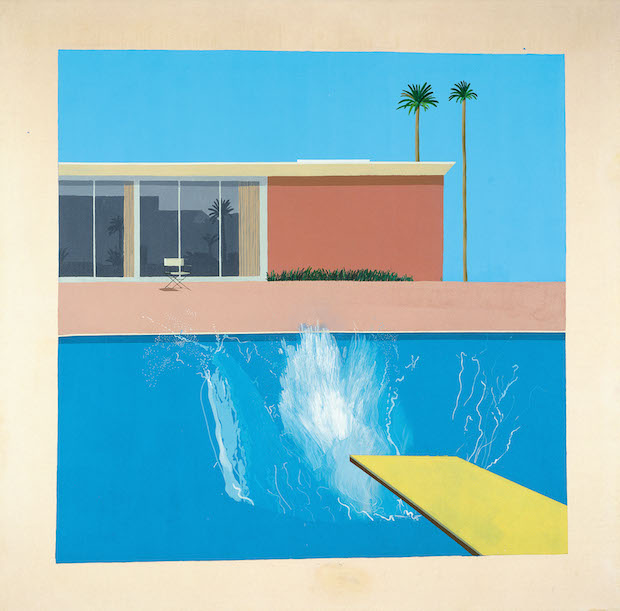
A Bigger Splash (1967), David Hockney. © David Hockney
Several of Hockney’s pool paintings will take centre stage in ‘David Hockney’, the major retrospective opening at Tate Britain this month (9 February–29 May). Spread across 13 rooms in the gallery, it will be the most extensive retrospective of Hockney’s work ever assembled, and will gather examples of work in all media from across the last six decades: oils and acrylics, pencil and charcoal drawings, iPad paintings, photo collages, and videos. Some of the works in the exhibition have never been on public display before; others have not been seen in the UK for decades. Several of the pictures in the exhibition feature a swimming pool, and the recurrence of the image seems to tie together many of Hockney’s concerns overall: the shifting relationship between painterliness and design in his work; the interest in forms of friendship and sociability; and the passion for bold colour and restless technical experiment.
Having made the celebrated paintings in acrylics of the 1960s and early 1970s, Hockney returned to the image of the swimming pool in many different media. He had already made successful experiments with the theme, in watercolours, crayons and lithographs, when in 1978 he made a series of works that were later exhibited under the name Paper Pools, using a new technique of adding coloured dyes into wet paper pulp, manipulating the pulp with various tools, and pressing it into sheets of paper. The resulting images are not works on paper so much as works in which form and texture inhere in the paper itself, with line and colour completely integrated in a manner that recalls the paper cut-outs of Matisse (who had made his own remarkable contribution to the genre of the pool picture in his 1952 cut-out, The Swimming Pool). Hockney has remarked that ‘this process with paper pulp demanded a lot of water; you have to wear boots and rubber aprons’, making the ‘watery subject’ of the pool a perfect fit, and in Paper Pools he produced a set of variations on the same theme, with powerfully simplified figuration, that rivals his earlier explorations in the more sophisticated medium of acrylic.
Next came Hockney’s own conceptual intervention in the photographic tradition, with his polaroid composite pictures of the early 1980s. The artist’s excitement at a new technical discovery is palpable in these works: in effect, he had found a way of making cubist photographs in which the viewpoint continually shifts as the viewer’s eye moves around the image. In his own words, he had made the polaroid camera into ‘an extraordinary drawing tool’ that allowed him once more to ‘represent on a flat surface the lovely and wonderful experience of looking’. The retrospective at Tate Britain will include Gregory Swimming, Los Angeles, March 31st 1982, made up of 120 polaroids laid out in a rectangular grid, eight down and 15 across, and the pool is again strongly suited to the new medium, as the shifting viewpoints amplify the shifting of the water’s surface, the differing ways light plays upon the pool as time passes, and the shuttling movement of the swimmer, laid out in a circular pattern.
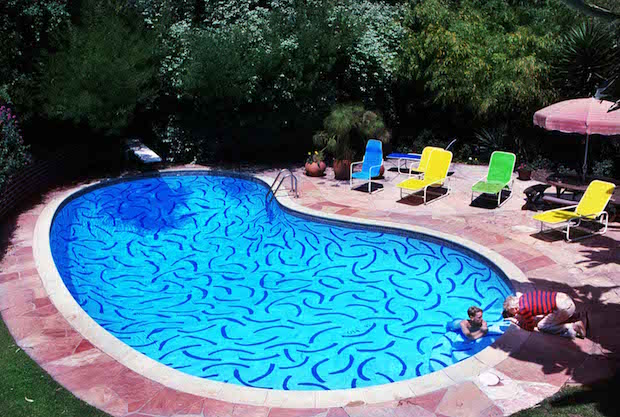
David Hockney with a model in the pool at Hockney’s house in the Hollywood Hills, in a 1978 photograph by Michael Childers. © Michael Childers
Hockney’s swimming pool paintings exerted a powerful influence on other artists. The 2012 exhibition ‘Backyard Oasis: The Swimming Pool in Southern California Photography, 1945–1982’, held at the Palm Springs Art Museum, showed the enabling example that Hockney’s pool paintings presented for several generations of photographers. The swimming pool was already a central concern of celebrity photography and ‘beefcake’ images, but Hockney’s exploration of it in the major paintings of the 1960s and early 1970s encouraged more adventurous artistic exploration of the theme. Nine Swimming Pools (1968) by Ed Ruscha, a friend of Hockney’s since his arrival in LA, is a good example: an assemblage of photographs of uncannily deserted and peaceful backyard pools, all shot from low angles, which come to seem like formalistic variations on Hockney’s theme. In Michael Childers’ photograph Hockney Swimmer (1978), meanwhile, a naked figure is seen mid front crawl, his right arm raised above his head, as he glides through the pool in Hockney’s own backyard in LA, on the bottom of which Hockney has painted a pattern of blue arcs executed in thick brushstrokes; some years later, Childers also produced a remarkable series of photographs of Hockney at work on his polaroid composites.
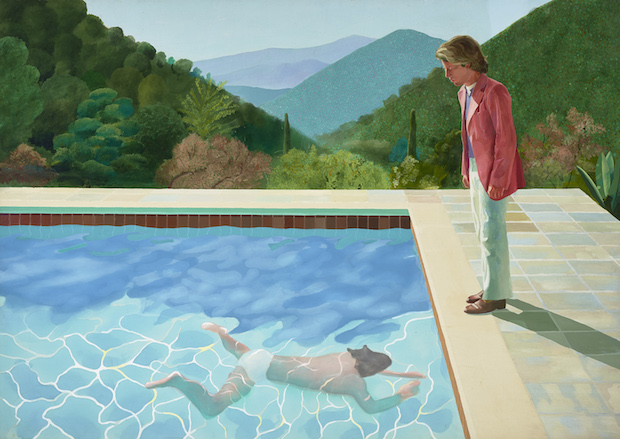
Portrait of an Artist (Pool With Two Figures) (1972), David Hockney. Photo: Art Gallery of New South Wales/Jenni Carter; © David Hockney
In film, Jack Hazan’s semi-fictional documentary A Bigger Splash (1973) takes as its subject the creation of Hockney’s major work of the early ’70s, Portrait of an Artist (Pool with Two Figures) (1972) – a painting set in a landscape of southern France, near Saint-Tropez, with a male figure in white trunks submerged under the water, swimming breaststroke, and the painter Peter Schlesinger, Hockney’s former partner, fully dressed and standing at the edge of the pool looking down. The film focuses on the unravelling of Hockney’s relationship with Schlesinger but also goes to inventive lengths to represent Hockney’s creative processes and to make moving images out of his pictures. In a similar manner, Pedro Almodóvar’s Bad Education (2004) alludes to several of Hockney’s pool paintings in a series of slow-motion tableaux vivants, which transplant paintings such as Peter Getting out of Nick’s Pool and Portrait of an Artist (Pool with Two Figures) to a minimalist house in the suburbs of Madrid, and make their sexual charge more explicit by casting adolescent boys in a plot of sexual awakening. And in 2015, a second film took the title A Bigger Splash, the loose remake of Jacques Déray’s La Piscine (1969) directed by Luca Guadagnino and starring Tilda Swinton and Ralph Fiennes, which took the Hockneyesque poolside setting, transplanted to Sicily, as the site for a decidedly hetero play-through of the theme of sexual jealousy.
For photographers and filmmakers, Hockney’s pool paintings could be engaged with head-on, since the translation of their imagery into a new medium left sufficient imaginative scope for original expression. For painters coming after Hockney who wished to paint images of swimming pools, however, more complex attitudes were necessary if the influence of their precursor’s work was not to be overpowering. In the years since Hockney first turned to the swimming pool as a subject, a number of other painters have explored its possibilities as a site of ambiguous glamour and desire.
In his 2012 memoir Bad Boy: My Life On and Off the Canvas, American painter Eric Fischl paid tribute to Hockney’s ‘protean sensibility […] capable of Olympian observations, of tripping over the surface of things, of picking up this and that and constructing brilliant, seductive worlds’, and recalled his own ambitions when he first started painting the nude beaches of Saint-Tropez: ‘I thought I was capturing something that was particularly French or European, the way the foreign eye of David Hockney had captured Los Angeles.’ As well as wishing to replay Hockney’s cultural crossover in reverse, Fischl has repeatedly returned to scenes in which naked or semi-naked figures are grouped around suburban swimming pools, in arrangements that, unlike Hockney’s more serenely domestic images, have distinctly Freudian implications. In Squirt (1982), for instance, a prepubescent boy in speedos, goggles and flippers stands by the poolside firing a water-pistol towards a woman lying face down on a sun lounger – or, in Fischl’s words, ‘unloading into the crotch of this woman’ who has ‘her legs spread apart’. Birth of Love (1981) shows a night-time pool party, the water glowing ominously, where a group of six children and one woman stand and sit poolside, all naked; the woman smokes a cigarette while a young boy places a hand on her hip. The paintings, all executed in oils with superbly skilled variations of thick brushstrokes and passages of finer detailing, invite us to find them simultaneously transgressive and touching. They also invite speculation on the pervy, voyeuristic positioning of the gaze, with its constant access to moments of private intimacy like the nakedness of parents and children, and its tendency to capture figures from behind with their backs to the viewer.
Fischl has described ‘male desire within a self-conscious, postfeminist world’ as one of his major concerns. His work in this direction has been taken up and extended by the work of the Scottish painter Caroline Walker, one of whose major poolside paintings, Role Reversal (2012), alludes to Fischl’s Imitating the Dog (Mother and Daughter II) (1984). In Fischl’s painting, a naked girl is down on all fours next to the family dog, her back and buttocks facing the viewer, while her mother, naked from the waist down and unaware that she is being watched, stands further off and fiddles with the strap of her bikini top. In Walker’s painting, a woman dressed in an orange swimming costume is down on all fours at poolside, eye-level with a King Charles spaniel, while the dog stares off to a point beyond the edge of canvas. The woman in Walker’s painting faces the viewer, but the mirrored door of the pool room behind her gives us the Fischlesque view of her upturned buttocks. Role Reversal is one of a series of oil paintings that were included in the artist’s 2013 exhibition at Pitzhanger Manor, ‘In Every Dream Home’ – a title borrowed from Roxy Music that sums up the combined glamour and sinisterness of Walker’s images. Those paintings were set at a modernist house in the north London suburbs, which looks like it could have been transplanted from LA or the South of France, with a swimming pool in the back garden around which three women of various ages pose in enigmatic combinations and scenarios. The compositions recall Hockney’s arrangements of male figures around the pool in improvised patterns of leisure and gay sociability, but with an added feminist self-awareness about the politics of the gaze and the observed body.
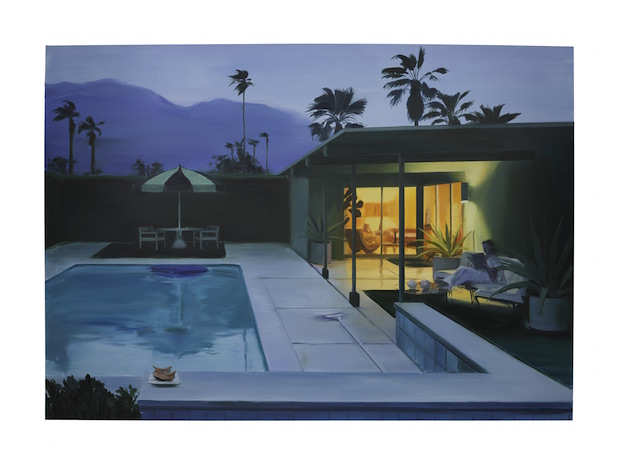
Desert Moon (2016), Caroline Walker
Walker has developed this in different directions in a number of subsequent works that linger on swimming pools. A series of paintings made in bathhouses in Budapest were exhibited in Korea in 2015, and further paintings have followed based on stills from François Ozon’s 2003 film The Swimming Pool, and on time spent at a private house in Palm Springs and a hotel in LA. Perhaps the most thrilling of them is Desert Modern (2016), a Palm Springs painting and the largest canvas Walker has worked on to date, in which the ominously muted glow of the pool at dusk stands in contrast with the rectangle of artificial light coming from a glass-fronted room and the distant outline of the mountains behind. In many of Walker’s pool paintings, how to render the surface of water is combined with an interest in the image-creating properties of reflective surfaces that seems to add a layer of self-consciousness to the creation of the whole painting.
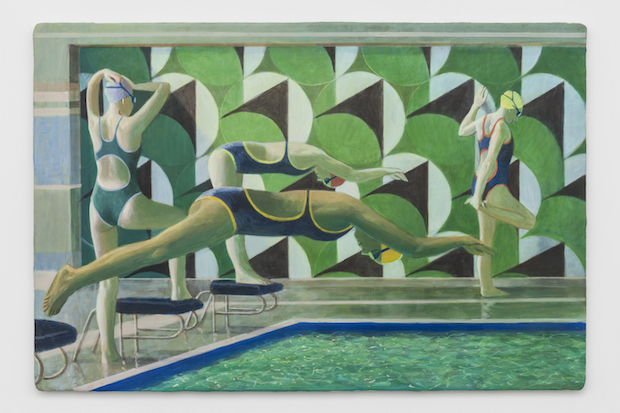
The Pool (2013), Benjamin Senior Courtesy of Carl Freedman Gallery, London and Monica de Cardenas, Milan; photo: David Morgan
Walker is not the only painter of more recent generations whose imagination has been charged by the possibilities of the swimming pool. In paintings such as Pool Party (2010) and several of the works in his 2016 exhibition ‘Enclave’, Jonathan Wateridge has created highly cinematic images in large-scale, almost photorealistic oil paintings that make the swimming pool the site of unexplained tension or looming disaster. Elizabeth Huey has created many oil and acrylic paintings of landscapes featuring public swimming pools, some of which were exhibited in 2013 under the title ‘Radiant Swim’, in which families and children are at play in compositions of busy activity and exuberant colour. And Benjamin Senior has turned his attention to Britain’s indoor municipal swimming pools as sites for an investigation into the geometric, illustrative possibilities of the athletic body, creating works in egg tempera that place the randomness of pattern displayed by water surfaces in contrast to a highly formalised vocabulary of human and architectural figures.
Having made representations of the swimming pool in so many different media – watercolours, oils, acrylics, photo collages, paper pulp – it only remained for Hockney to paint a swimming pool itself, which he did not only at his own home but also at the Roosevelt Hotel in Hollywood in 1988. The huge mural he created on the floor and walls of the Roosevelt pool is comprised of a freehand pattern of curved lines like apostrophes, which form a complete, interwoven pattern when the water is still but dance and shimmer when it is disturbed. The beautiful naked people of California were now able to swim in a work by Hockney, having first inspired his imagination a quarter of a century earlier. And his fascination with the image of the swimming pool continues, a quarter of a century after he painted the Roosevelt pool. Two of the recent works in the Tate retrospective are a pair of large charcoal drawings made in 2013, entitled Pool Garden Morning and Pool Garden Evening – signs of an ongoing investigation by a man who once said, ‘Water, I can’t describe it with words, it’s so elusive.’
From the February issue of Apollo. Preview and subscribe here.
Unlimited access from just $16 every 3 months
Subscribe to get unlimited and exclusive access to the top art stories, interviews and exhibition reviews.

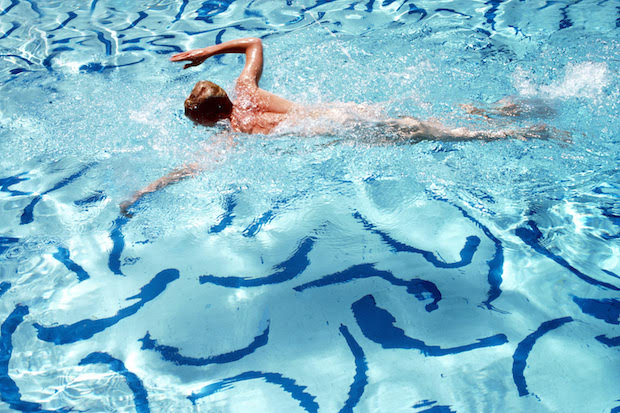
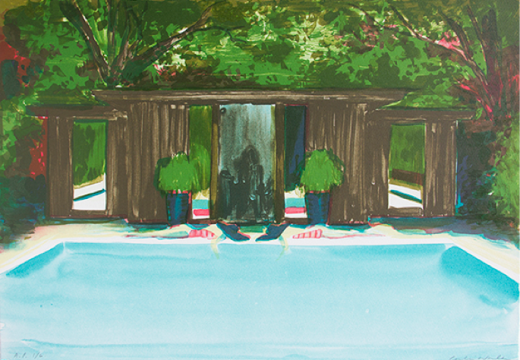

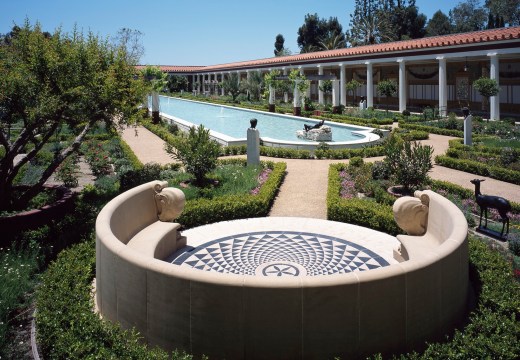









![Masterpiece [Re]discovery 2022. Photo: Ben Fisher Photography, courtesy of Masterpiece London](http://www.apollo-magazine.com/wp-content/uploads/2022/07/MPL2022_4263.jpg)
Has the Fitzwilliam lost the hang of things?